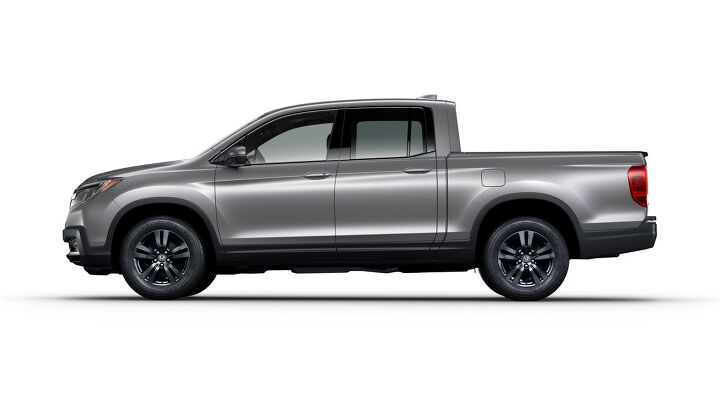Honda Ridgeline AWD Takes a Huge Price Jump for 2018 - Is Honda Shooting It in the Foot Again?
Suggesting that the automaker is “providing a more compelling value,” American Honda is removing the second-from-the-bottom RTS trim level from the 2018 Honda Ridgeline lineup and extinguishing the all-wheel-drive option on basic RT Ridgelines.
As a result, after a 2017 run in which all-wheel-drive Ridgelines could be purchased for $32,315, the 2018 Honda Ridgeline AWD now has a base price $3,695 higher than before.
$36,010.
If the unibody 2017 Honda Ridgeline, an undeniably compelling (if not convincing) package was already not fully capable of swaying most pickup truck customers, the 2018 Honda Ridgeline AWD’s price is now $3,950 more costly than the Toyota Tacoma SR 4×4 Double Cab, $4,045 pricier than the Chevrolet Colorado WT 4×4, and $7,010 more expensive than the Nissan Frontier S 4×4 Crew Cab.
Granted, there’s not a direct equipment comparison between the 2018 Honda Ridgeline Sport AWD and those basic editions of competing body-on-frame pickup trucks. In the $36,010 Ridgeline Sport AWD, there’s a 7.3-cubic-foot in-bed trunk, NBA-style legroom, proximity access, pushbutton start, tri-zone auto climate control, and peerless ride quality.
But we’ve seen how limited the Ridgeline’s sway is in America’s pickup truck arena. Yes, it’s been limited by capacity the Alabama assembly plant where Honda also builds Odysseys, Pilots, and Acura MDXs. Yes, it’s grabbing market share, accounting for 9 percent of America’s midsize pickup truck market in 2017; up from 1 percent a year ago. But 99 percent — literally 99 percent — of pickup truck buyers choose something other than the Ridgeline.
Making the AWD Ridgeline more expensive to get into doesn’t sound like a recipe for greater marketplace success. Honda says the streamlining of the Ridgeline lineup will “better suit the needs of midsize truck buyers.” But what’ll it do for midsize truck buyers who want an affordable Honda with all-wheel drive?
According to Honda public relations manager James Jenkins, there haven’t really been any customers for affordable AWD Ridgelines because Honda wasn’t building them. In keeping with Honda’s typical formula, the early product mix coming out of the Lincoln, Alabama assembly plant was initially biased toward more costly trims. “But even after the launch, the demand for the top trims remained very high,” Jenkins tells TTAC.
In other words, though Honda isn’t selling huge numbers of Ridgelines, the Ridgelines Honda is selling are of the pricier variety. Thus, says Jenkins, “It wasn’t that they [RT and RTS AWD Ridgelines] weren’t selling. We essentially weren’t making many of them to begin with, as the demand for them was low.”
Across the remaining elements of the 2018 Ridgeline lineup, price changes are minor, amount to around $150 increases across the board.
Lest we forget, pricing was considered a problem with the first-generation Honda Ridgeline, a pickup that became progressively less popular during its decade-long run. After peaking in 2006, the first Ridgeline suffered year-over-year U.S. sales declines in five consecutive years, plunging more than 80 percent in the process.
It’s not difficult to see that Honda is once again positioning the Ridgeline in what many conventional pickup truck buyers will consider an uncomfortable price bracket. It’s important, if Honda is going to remove affordability from the Ridgeline AWD’s character traits, that Honda doesn’t afflict the second Ridgeline with another first-gen fault: a striking lack of updates. In America’s hugely active truck sector, Honda can’t leave the uncomfortably pricey second-generation Ridgeline alone for three years, let alone five or ten like last time.
Meanwhile, across the northern border, all Honda Ridgelines come standard with all-wheel drive. The basic Ridgeline LX model is priced at the USD equivalent of $30,891.
[Images: Honda]
Timothy Cain is a contributing analyst at The Truth About Cars and Autofocus.ca and the founder and former editor of GoodCarBadCar.net. Follow on Twitter @timcaincars.
More by Timothy Cain
Latest Car Reviews
Read moreLatest Product Reviews
Read moreRecent Comments
- ToolGuy The Supercharger in the last picture: Is it 2B, or not 2B?
- 1995 SC "But your author does wonder what the maintenance routine is going to be like on an Italian-German supercar that plays host to a high-revving engine, battery pack, and several electric motors."If you have to ask...
- Loser I love these MN12 vehicles. We had a 92 Cougar, my dad had an 89, mom and brother both had T-birds. Wife and I still talk about that car and wish they still made cars like these. It was a very good car for us, 130,000 miles of trouble free and comfortable driving. Sold it to a guy that totaled it a month after purchase. Almost bought a 97 T-bird the 4.6 when I found out it was the last of them but the Cougar was paid for and hard to justify starting payments all over.
- CoastieLenn I would do dirrrrrrty things for a pristine 95-96 Thunderbird SC.
- Whynotaztec Like any other lease offer it makes sense to compare it to a purchase and see where you end up. The math isn’t all that hard and sometimes a lease can make sense, sometimes it can’t. the tough part with EVs now is where is the residual or trade in value going to be in 3 years?



































Comments
Join the conversation
The ridgeline is not a real pickup truck. It's a doctored Odyssey/Pilot. If all you want to haul is a few flats of pansies from your local nursery, fine. If you want to haul or tow something real, good luck. Further, Honda has no idea how to do 4wd/AWD decently. Watch comparisons of Honda vs. Subaru to see just how bad Honda is in this regard. Honda needs to stick to minivans and sedans. Leave the SUVs and trucks to other manufacturers who have some expertise in these types of vehicles.
I hope with that new increase one can get a real volume knob.